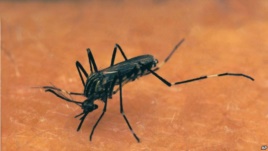VOA慢速英语:Philippines Plans for Disasters
30 October, 2013
Hello. It is nice to be with you again. I'm Jim Tedder in Washington. Today we travel to the Philippines to hear how officials are using technology to plan for natural disasters. In the second part of the show, we turn our attention to health news, and the fight against the disease malaria. Listen carefully, and use what you hear to learn or improve your English. As It Is ... is coming your way.
The Philippines often suffers more natural disasters than other countries. Philippine disaster risk planners have begun using a new tool to make maps of at risk areas in Manila. This technology will help identify weak structures, measure population density and predict financial losses should disaster strike.
The Philippines lies on tectonic plates at the bottom of the Pacific Ocean. The movement of tectonic plates can cause earthquakes and volcanic activity. Other natural disasters have resulted from tropical storms and heavy rain.
Over the years, different maps have shown active fault lines and places where flooding could happen. Recently, the national government in the Philippines gave maps to officials in Metropolitan Manila. The maps show the effects of earthquakes, wind damage from storms and flooding from heavy rain.
The scenarios – or possible situations -- were made with LiDAR, a sensing technology that lights up buildings and other objects with lasers.
Renato Solidum heads the Philippine Institute of Volcanology and Seismology. His office produced the risk analysis of earthquake scenarios. He says these new maps help planners with what he calls their "disaster imagination."
"Sometimes in order to convince decision-makers and even(other) people to do things right away is, you have to show how many people will die, how many buildings will suffer, how many millions of pesos would you need to rehabilitate (restore) or replace this. You need damage or impact figures, rather than the threat."
In the risk analysis project, one scenario shows a 7-point-2 earthquake in the Manila area would result in 37,000 deaths. The damage would cost an estimated 56 million dollars to repair.
The Philippines not only suffers from natural disasters. Its population centers have factors, or issues, that increase the chance of risk. They include fast growth and violations of rules like building codes. Other concerns include poor people living in areas that often flood, and poor solid-waste treatment.
Researchers on the project created what they call an "exposure database." It combines population and structural information, such as a building's age and where development has spread. In exchange for getting the computer software, city planners have to add details from their localities to the database.
Ishmael Narag is a researcher with the Institute of Volcanology and Seismology. He says being prepared for disasters does not have to depend on technology. He says smaller, poorer communities can use available information from population counts and other studies. He says this information can help them come up with their own estimate of risk.
Herbert Bautista is the mayor of Quezon City and president of the League of Cities of the Philippines. He calls the new maps and information database, "a big deal for local government." He says this new tool will help local governments obey a national law that requires land-use plans to include risk areas. Mr. Bautista says the information can help the government stop developers from trying to build homes on fault lines or soil that easily takes in water.
And, Mr. Narag says getting information from cities will be important to the success of using the new tool for disaster reduction planning. In his words, "The science is only as good as what the date could give, so it's very important that this is communicated to the local government.
The Australian and Philippine governments made possible the project that led to the creation of the maps and the data base. Financing came from the Australian Agency for International Development.
Malaria Fight Continues
Attacking mosquitoes early in their development may help with efforts to control malaria. The disease kills an estimated 660,000 people every year, mostly in Asia and in areas south of the Sahara Desert. Steve Ember joins us with the latest information.
 |
| Mosquito bites a human arm.. |
One way to prevent malaria is by using mosquito nets treated with long-lasting insecticides. Another way is to spray such chemicals inside buildings. Both methods target adult mosquitoes. However, the insects are developing resistance to the chemicals.
Another method targets mosquito larvae, the young, not yet fully developed mosquito. This method is called larval source management, or LSM.
Recently, researchers examined 13 studies of LSM from eight countries.
Lucy Tusting is with the London School of Hygiene and Tropical Medicine. She says the new research is important because a number of African and other countries are using larval source management. However, she says, opinions differ about the value of LSM and where it should be used.
"There's a real lack of consensus on how effective the method can be and in which settings it's appropriate."
Targeting mosquitoes early would seem to be a valuable addition to any control program. But Lucy Tusting says it is not easy to decide whether to use the method.
"First of all, we do have very, very effective existing methods of malaria control. Long-lasting insecticide-treated nets and indoor residual spraying are both highly effective."
She says these methods have been a major reason for the successes in malaria control in recent years. But because of those successes, scientists believe there has been less need to look at other ways to fight the disease. Fewer studies have been organized.
The World Health Organization has released guidelines, suggestions, on the use of LSM. Currently the organization does not support of using larvacides in rural sub-Saharan Africa unless there are conditions that limit the habitats of mosquito larvae.
VOA's Steve Ember with some important information about the fight against malaria.
 |
| Happy Halloween |
And I'm Jim Tedder in Washington, thanking you for spending some time with us on this last Thursday of October. It is a special day in the United States, and in many other parts of the world. It's Halloween, or "All Hallow's Eve." Young and old alike dress up in scary costumes and either attend parties, or go door-to-door saying, "Trick or treat," and asking for candy.
Historians say it is a very old holiday that started in Europe 1400 years ago. So to one and all, "Happy Halloween" from all of us at VOA. More learning English programs are right around the corner, as is world news, at the beginning of the hour.
- 频道推荐
- |
- 全站推荐
- 推荐下载
- 网站推荐




















